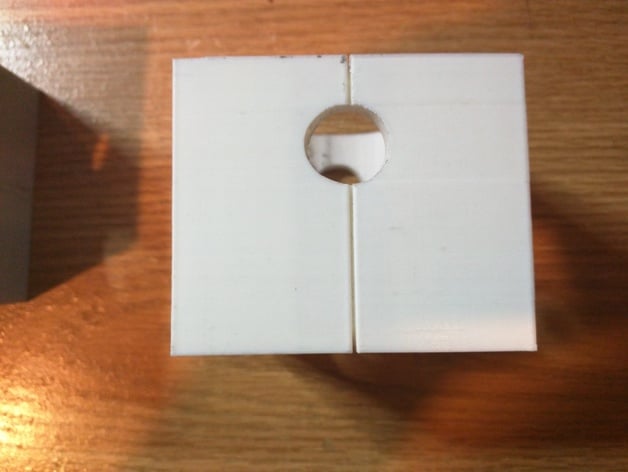
Quadrifilar Helix Antenna Cross Arms Drill Guide
thingiverse
These precision guides were engineered to craft a Quadrifilar Helix Antenna (QFH) using an infinite balun design tuned to 137.5 MHz for the NOAA 19 Satellite as described below: Original Build Guide: http://www.qsl.net/yo4tnv/docs/ARRL%20UHF%20Microwave%20Projects%201997.pdf (Page 1-39) Step by Step instructions: http://www.rish.kyoto-u.ac.jp/digitalbeacon/information/Building_QFH_Antenna_Guide.pdf Dimensions of Tubes Used: Main Column: 2-inch PVC tube with an outer diameter of 2.4 inches Leg tubes: 1/2-inch PVC tube with an outer diameter of 0.6 inches Words of Caution: This antenna drill guide is exclusively designed for constructing a QFH antenna tuned to 137.5 MHz. You might get away with frequencies around the 137 MHz region, but it's definitely not suited for wifi or short wave radio. So don't assume your antenna will work using these guides. Design & Test Adventure: Since I didn't have a drill press capable of drilling through holes, I tried various techniques to drill arm holes at 90-degree angles with no luck. I would either end up with weird offset holes out of angle or perfect-looking holes that looked distorted when the cross arms were fitted in. To fix this issue, I researched and designed (and redesigned) these guides using Tinkercad. After printing them, I used a slotted line to align with drill targets I made for easier alignment, then marked the holes, and voila! Perfectly aligned 90-degree holes. You can see the final results in the actual antenna now mounted outside. The cross arm holes in the main column are what these guides are designed for. Due to my success with this first-ever 3D print, I proudly purchased a FlashForge Creator Pro 2016 model, which has proven to be one of the best investments since my university education. Future Changes: In the future, I plan to modify this design to simplify leg holes to a single point that can be marked with a pencil tip. The current design might seem clumsy, but it works well and caters to users who may use different size piping than recommended in the step-by-step guide mentioned above. Another addition would be horizontal grooves to align with markings drawn around the perimeter of the center main column. Print Settings Printer Brand: MakerBot Printer: MakerBot Replicator 2X Rafts: No Supports: Yes Resolution: 0.3 Infill: 15% Notes: This was printed on a Makerbot at Makerthings in Montreal, Canada. The print settings above seem correct and what I remember the clerk telling me he used. This design is easy to print, so you can use whichever settings you feel comfortable with. Post-Printing After printing these guides, I noticed that not all 2-inch and 1/2-inch pipes are identical, so you may need to sand holes for a snug fit. Other than sanding, there's nothing else that needs to be done.
With this file you will be able to print Quadrifilar Helix Antenna Cross Arms Drill Guide with your 3D printer. Click on the button and save the file on your computer to work, edit or customize your design. You can also find more 3D designs for printers on Quadrifilar Helix Antenna Cross Arms Drill Guide.
